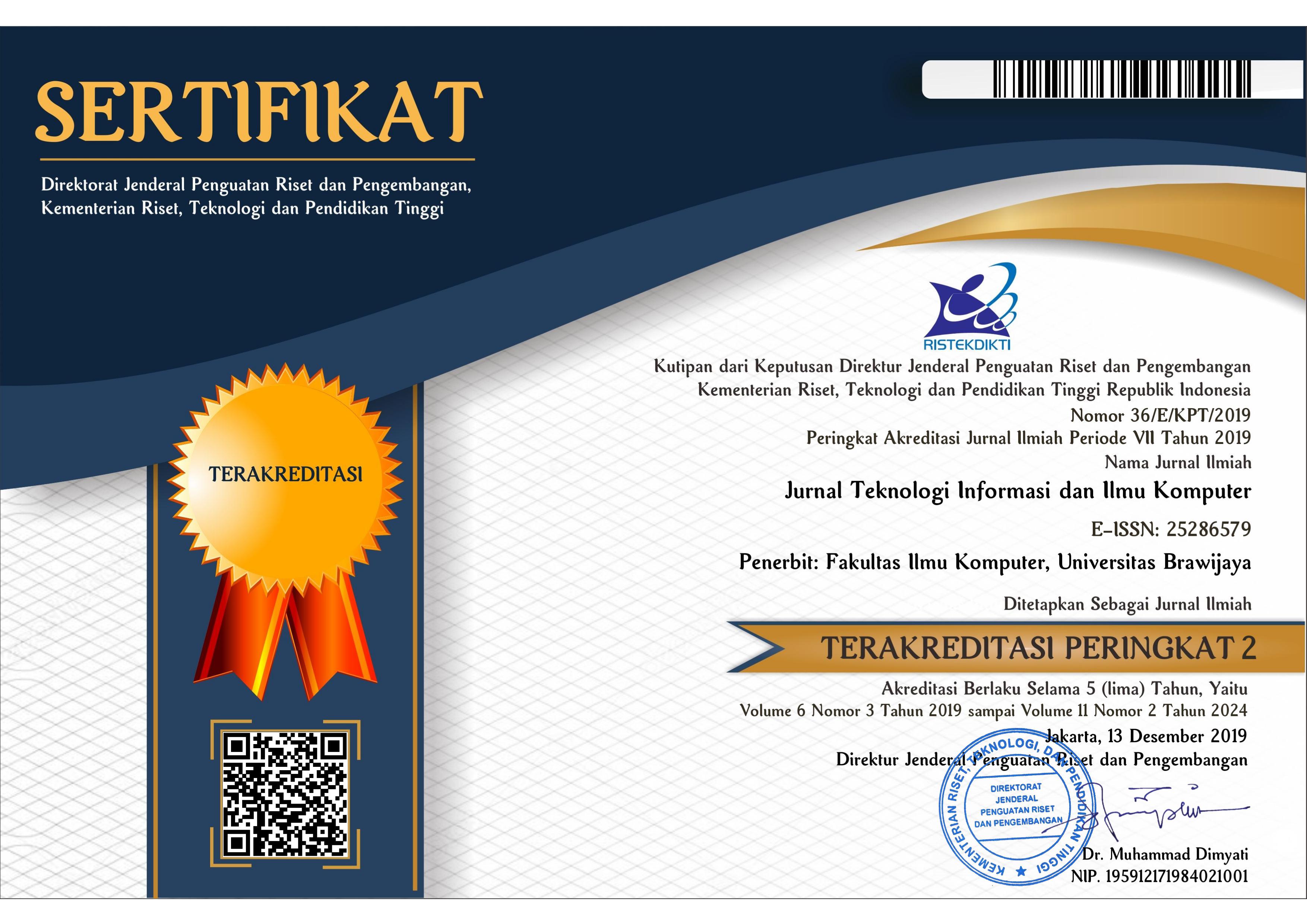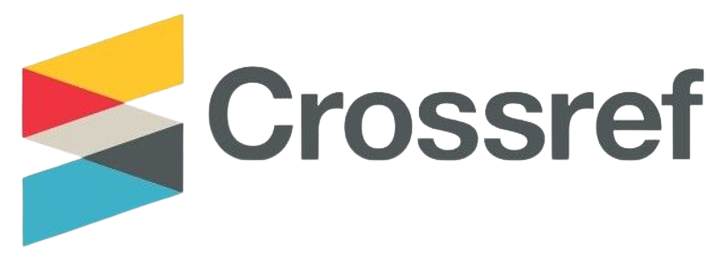Implementasi HPack dan Gzip pada Optimasi Aplikasi Dengan Arsitektur Microservice
DOI:
https://doi.org/10.25126/jtiik.20241128287Kata Kunci:
arsitektur microservice, kompresi data, HPack, GzipAbstrak
Penelitian ini mengkaji penerapan arsitektur microservice dalam pengembangan aplikasi web, dengan fokus pada optimasi komunikasi antar layanan melalui kompresi data. Dengan latar belakang permasalahan bottleneck dalam transfer data antar layanan, tujuan utama penelitian ini adalah mengatasi tantangan tersebut dengan memanfaatkan teknologi kompresi HPack dan Gzip, terutama dalam konteks penggunaan format data JSON yang umum dalam komunikasi antar layanan. Penelitian dilakukan melalui tahapan analisis kebutuhan, desain sistem, implementasi, deployment dan pengujian. Data uji yang merupakan respons dari microservice yang berupa 34 item JSON Array yang dikompresi menggunakan Hpack, Gzip dan gabungan keduanya. Proses pengukuran waktu dan ukuran respons untuk setiap jenis kompresi dilakukan menggunakan Chrome DevTools, dengan analisis data yang dilakukan menggunakan alat bantu pandas. Hasil pengujian menunjukkan penurunan sebanyak ~79,4% dari 12991 bytes dalam ukuran respons dan penurunan waktu respons sebanyak ~8,7% dari 641,401 ms. Hal ini menegaskan efektivitas HPack dan Gzip dalam meningkatkan performa aplikasi microservice. Penelitian ini memberikan wawasan dalam optimasi aplikasi microservice dan rekomendasi praktik terbaik dalam pemilihan metode kompresi data.
Abstract
This study examines the implementation of microservice architecture in web application development, with a focus on optimizing communication between services through data compression. Given the background issue of bottleneck in data transfer between services, the primary objective of this research is to address this challenge by leveraging HPack and Gzip compression technologies, especially in the context of using the common JSON data format for inter-service communication. The research was conducted through stages of requirements analysis, system design, implementation, deployment, and testing. Test data consists of responses from microservices in the form of a 34-item JSON Array compressed using HPack, Gzip, and a combination of both. The process of measuring response time and size for each compression type was carried out using Chrome DevTools, with data analysis performed using pandas tools. The test results show a reduction of approximately 79.4% from 12991 bytes in response size and a decrease in response time by about 8.7% from 641.401 ms. This confirms the effectiveness of HPack and Gzip in enhancing microservice application performance. The study provides insights into microservice application optimization and recommendations for best practices in selecting data compression methods.
Downloads
Referensi
ADEK, R.T., BUSTAMI, B., ULA, M., 2023. Systematics Review on Detecting Cyberattack Threat by Social Network Analysis and Machine Learning. Lecture Notes in Networks and Systems 448, 567–577.
BRAY, T., 2017. The JavaScript Object Notation (JSON) Data Interchange Format, Request for Comments. RFC Editor.
DRAGONI, N., GIALLORENZO, S., LAFUENTE, A.L., MAZZARA, M., MONTESI, F., MUSTAFIN, R., SAFINA, L., 2017. Microservices: Yesterday, today, and tomorrow. In: Present and Ulterior Software Engineering. Springer International Publishing, pp. 195–216.
LEWIS, J., FOWLER, M., 2014. Microservices [WWW Document]. URL https://martinfowler.com/articles/microservices.html (accessed 3.22.23).
OBJELEAN, A., 2011. JSON Compression Algorithms.
PEON, R., RUELLAN, H., 2015. HPACK: Header Compression for HTTP/2.
RICHARDS, M., 2022. Software architecture patterns, Second Edition. ed. O’Reilly Media, Inc., Sebastopol.
RICHARDSON, C., 2018. Microservices patterns: with examples in Java. Simon and Schuster.
SALAH, T., ZEMERLY, M.J., Yeun, C.Y., Al-Qutayri, M., Al-Hammadi, Y., 2017. The evolution of distributed systems towards microservices architecture. 2016 11th International Conference for Internet Technology and Secured Transactions, ICITST 2016 318–325.
ULA, M., ADEK, R.T., BUSTAMI, B., 2021. Emarketplace Performance Analysis Using PIECES Method. International Journal of Engineering, Science and Information Technology 1, 1–6.
Unduhan
Diterbitkan
Terbitan
Bagian
Lisensi
Hak Cipta (c) 2024 Jurnal Teknologi Informasi dan Ilmu Komputer

Artikel ini berlisensiCreative Commons Attribution-ShareAlike 4.0 International License.

Artikel ini berlisensi Creative Common Attribution-ShareAlike 4.0 International (CC BY-SA 4.0)
Penulis yang menerbitkan di jurnal ini menyetujui ketentuan berikut:
- Penulis menyimpan hak cipta dan memberikan jurnal hak penerbitan pertama naskah secara simultan dengan lisensi di bawah Creative Common Attribution-ShareAlike 4.0 International (CC BY-SA 4.0) yang mengizinkan orang lain untuk berbagi pekerjaan dengan sebuah pernyataan kepenulisan pekerjaan dan penerbitan awal di jurnal ini.
- Penulis bisa memasukkan ke dalam penyusunan kontraktual tambahan terpisah untuk distribusi non ekslusif versi kaya terbitan jurnal (contoh: mempostingnya ke repositori institusional atau menerbitkannya dalam sebuah buku), dengan pengakuan penerbitan awalnya di jurnal ini.
- Penulis diizinkan dan didorong untuk mem-posting karya mereka online (contoh: di repositori institusional atau di website mereka) sebelum dan selama proses penyerahan, karena dapat mengarahkan ke pertukaran produktif, seperti halnya sitiran yang lebih awal dan lebih hebat dari karya yang diterbitkan. (Lihat Efek Akses Terbuka).















